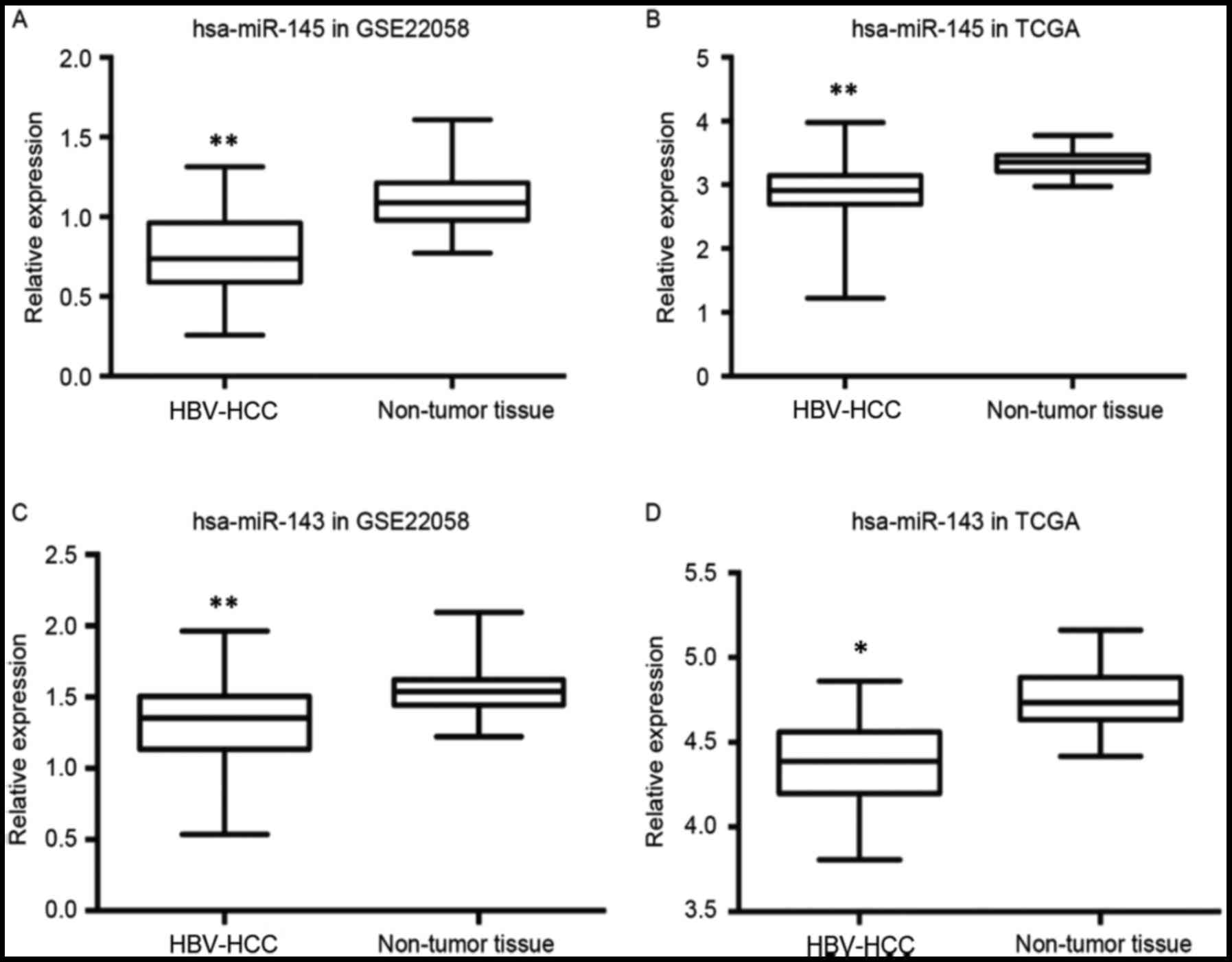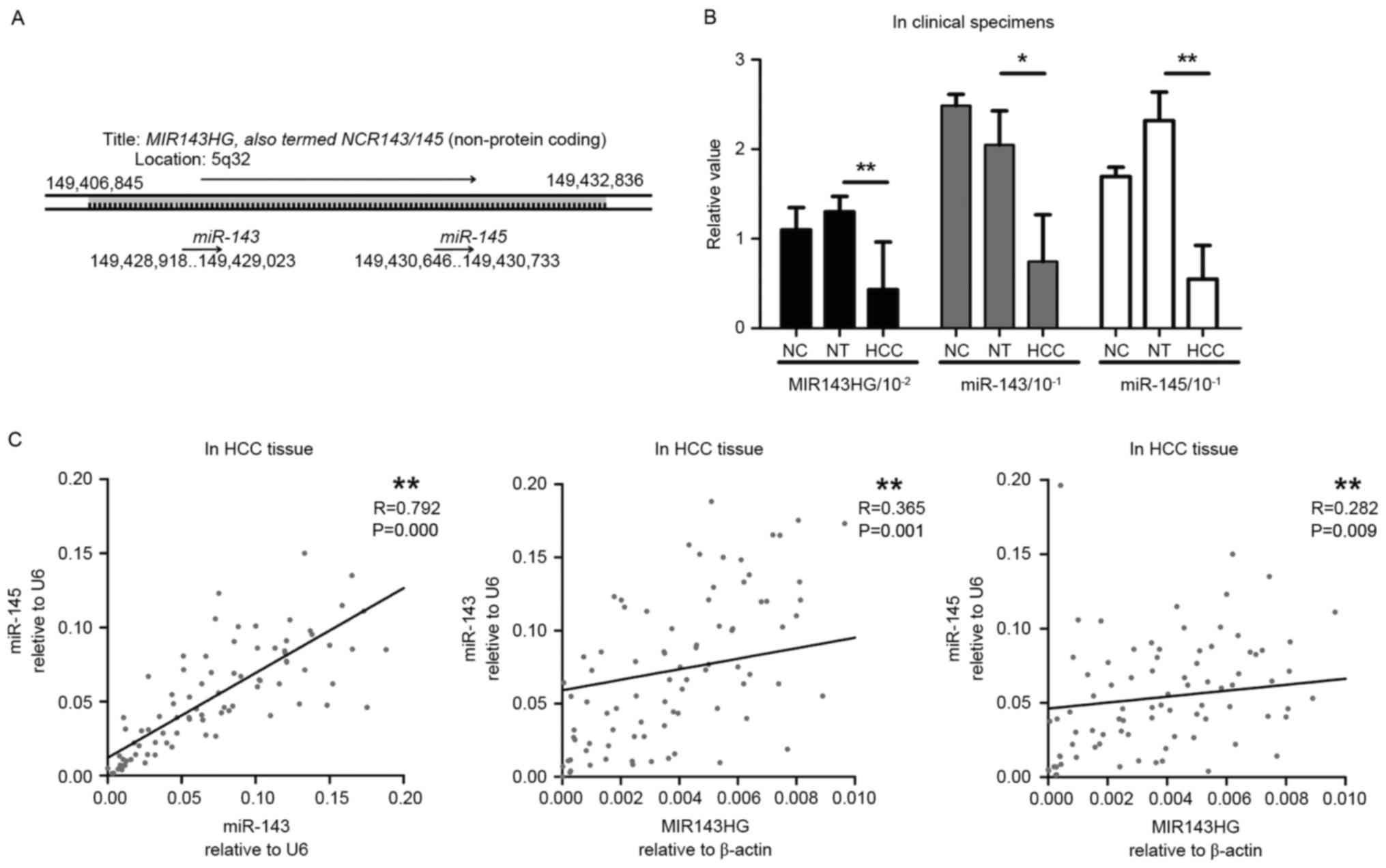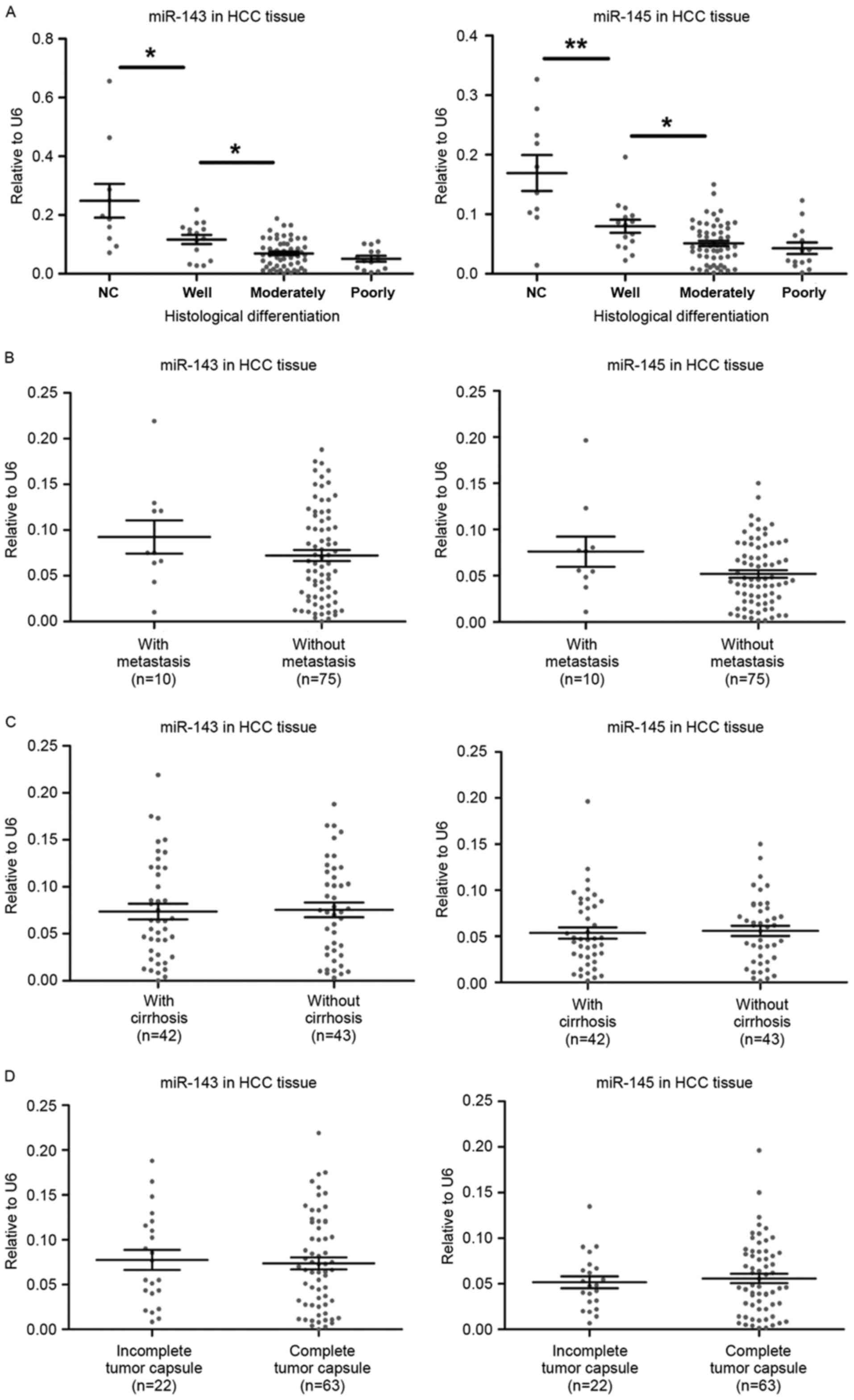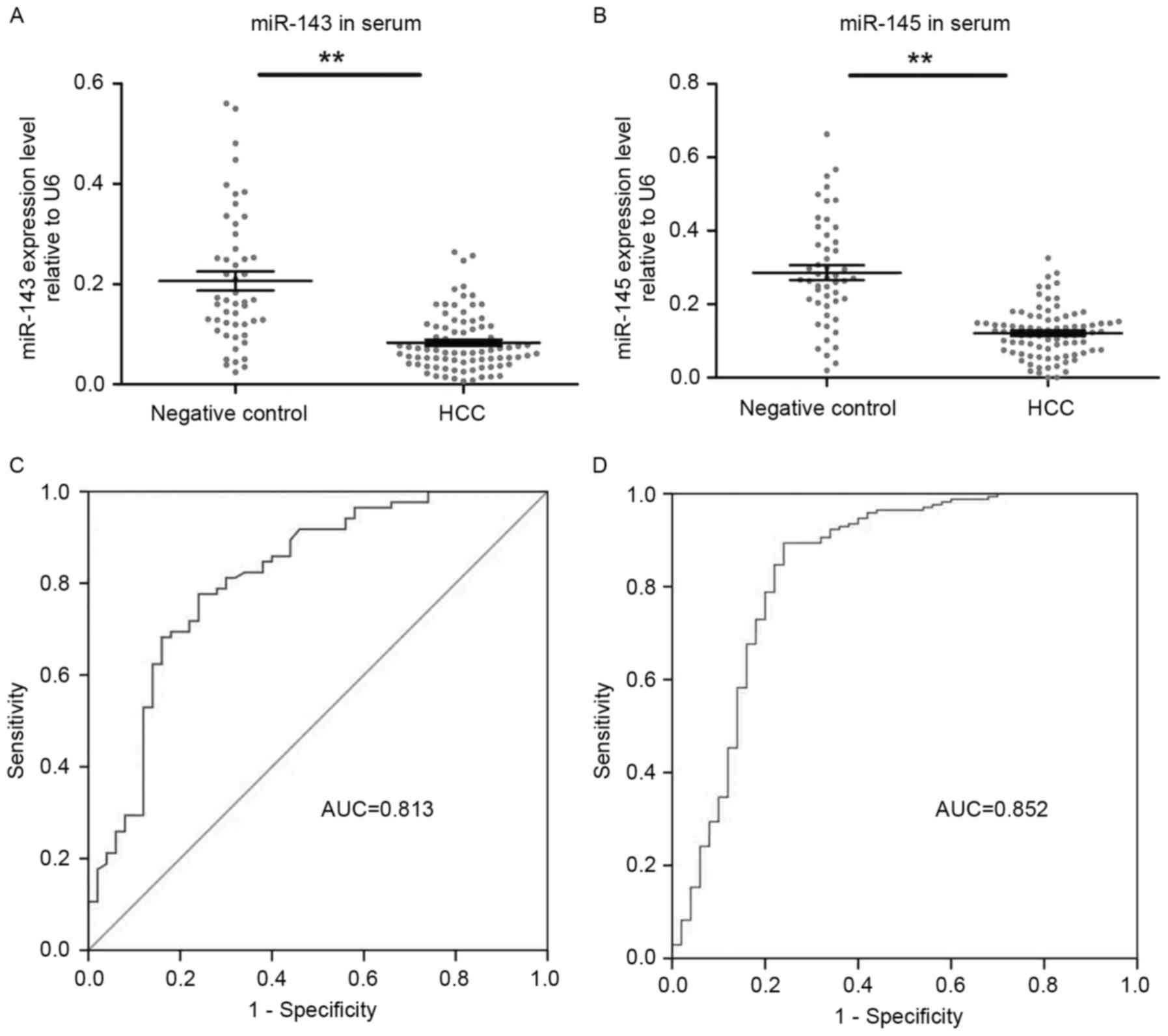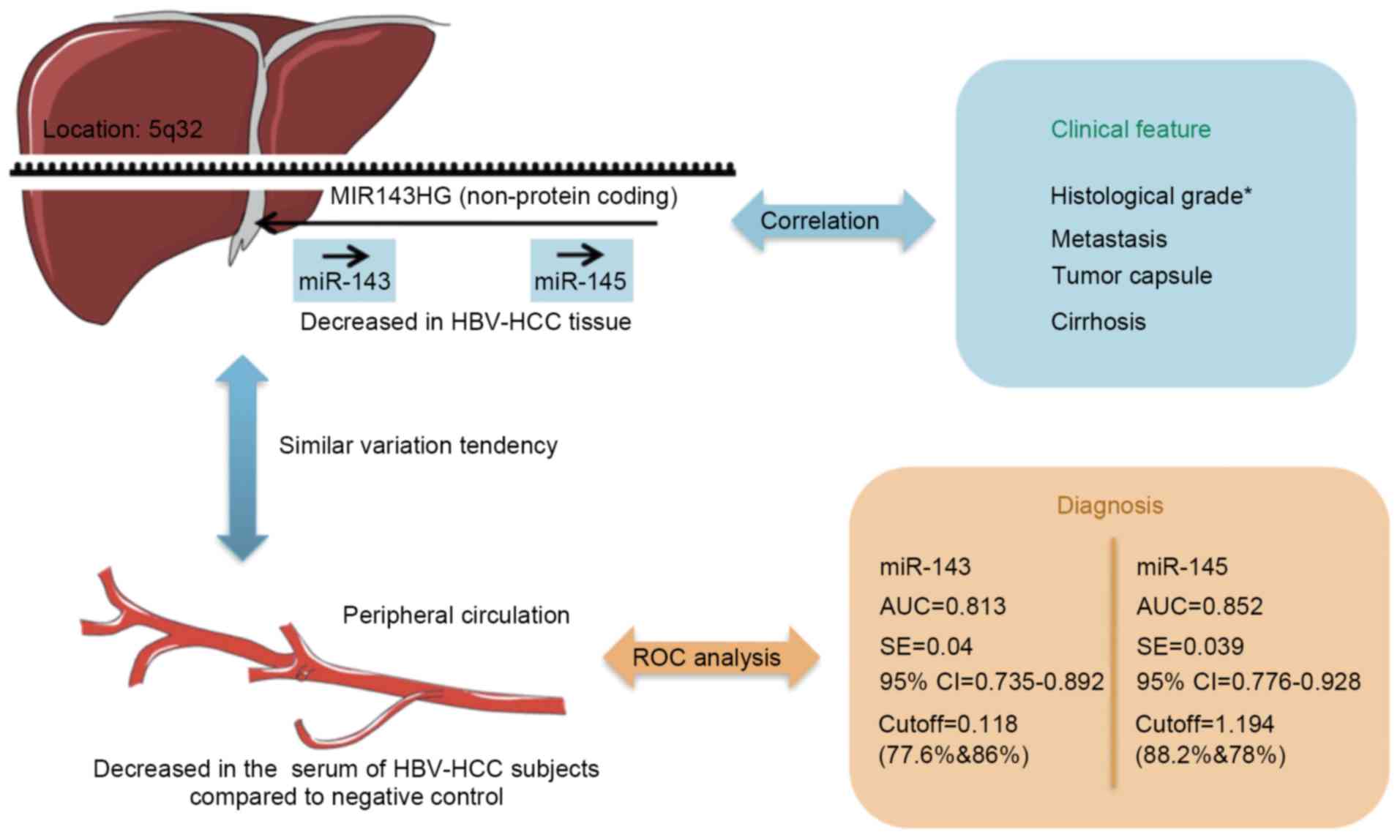Expression of the microRNA-143/145 cluster is decreased in hepatitis B virus-associated hepatocellular carcinoma and may serve as a biomarker for tumorigenesis in patients with chronic hepatitis B
- Authors:
- Published online on: February 26, 2018 https://doi.org/10.3892/ol.2018.8117
- Pages: 6115-6122
-
Copyright: © Zhao et al. This is an open access article distributed under the terms of Creative Commons Attribution License.
Abstract
Introduction
Hepatocellular carcinoma (HCC) is the third most common cause of cancer mortality worldwide. A variety of risk factors may promote HCC genesis, including hepatitis B virus (HBV) infection, hepatitis C virus infection, heavy alcohol consumption and non-alcoholic fatty liver disease (1,2). In the last decade, a marked increase in the incidence of HBV-associated HCC has been observed, particularly in China. Since the prognosis of patients with HCC is markedly dependent on the stage of the disease, strategies for early detection of HCC have been investigated.
MicroRNAs (miRNAs) are short 20–22-nucleotide single-stranded RNA molecules, which have been associated with epigenetic regulation in a range of diseases, including tumorigenesis (3–5). miRNAs regulate gene expression by altering the stability or the translational efficiency of target mRNAs. A previous study demonstrated that miRNAs are detectable and stable in serum (6); therefore, research has focused on the possibility of using miRNAs as biomarkers for predicting the diagnosis and prognosis of several diseases.
Two human miRNAs, miRNA-143 (miR-143) and miR-145 have been investigated as biomarkers for several types of cancer. miR-143 and miR-145 are stably expressed homologous miRNAs located within the same host gene, MIR143HG (7). The first study to examine the miR-143/145 cluster focused on HBV-associated HCC. This study demonstrated that miR-143 expression was increased in HBV-associated HCC tumors and was associated with invasive and metastatic behavior of liver tumor cells (8). Conversely, evaluation of the miR-143/145 cluster expression in other types of tumor, including colonic carcinoma, pulmonary carcinoma, esophageal carcinoma and prostatic carcinoma (9–12), demonstrated that the miR-143/145 cluster expression level was decreased. This raises the question of why the miR-143/145 cluster is overexpressed in HBV-associated HCC-derived tumors, but is underexpressed in other types of tumor. However, previous studies have produced contradictory results (13–15), demonstrating that the miR-143/145 expression level was decreased in HBV-associated HCC-derived tumors which contradicts the results of another previously mentioned study (8). Furthermore, a previous study demonstrated that the expression of the miR-143/145 cluster was negligible in liver tissues, including normal liver tissue or HBV-associated HCC tissue (7). This controversy was investigated further in the present study.
In the present study, the expression profile of miR-143 and miR-145 in HBV-associated HCC tissues and non-tumor tissues was investigated using chromatin immunoprecipitation (ChIP) data from The Cancer Genome Atlas (TCGA) and the Gene Expression Omnibus (GEO) datasets. Their expression in HBV-associated HCC tissue was also validated using the reverse transcription-quantitative polymerase chain reaction (RT-qPCR). The association between miR-143/145 expression and specific clinical features including tumorigenesis, tumor progression and prognosis was subsequently examined. Finally, the serum expression of miR-143 and miR-145 was determined to evaluate their potential clinical applications. The receiver-operating characteristic (ROC) curves were used to explore their potential value as biomarkers for predicting HBV-associated HCC tumorigenesis.
Materials and methods
TCGA miRNA dataset
The miRNA expression profile of 372 patients with HCC and 50 non-tumor distal liver samples was obtained from the TCGA dataset (cancergenome.nih.gov). According to the clinical information, 102 patients with HBV infection were selected as negative control.
GEO dataset
The GEO database (16) was accessed to obtain the normalized miRNA microarray dataset GSE22058 (www.ncbi.nlm.nih.gov/geo/query/acc.cgi?acc=GSE22058), which represents the miRNA expression profile of tumor and adjacent non-tumor tissues of 96 patients with HCC. From these patients, ~88% were confirmed positive for the HBV antigen (17).
Identification of differentially expressed miRNAs
For each dataset, the Wilcoxon signed-rank test was used to identify the differentially expressed genes between tumor and non-tumor samples. The null hypothesis was that a gene was not differentially expressed between the two groups and rejection of this hypothesis indicated that the gene was differentially expressed. A miRNA was considered upregulated if P<0.01 and its fold increase was ≥1.5. Downregulated miRNAs were similarly defined.
Clinical samples
HBV-associated HCC tissues, matched distal non-cancerous liver tissues and 5 ml venous peripheral blood were obtained from 85 patients with HBV-associated HCC from February 2012 to January 2013 at the Provincial Hospital Affiliated to Shandong University (Jinan, China). The mean patient age was 53.2±9.3 years (range, 25–75 years), and 70.6% of the patients were male. Ten tissue samples from patients with hepatic hemangioma and 5 ml venous peripheral blood from 50 patients with chronic hepatitis B were collected as negative controls. All tissue samples were histologically confirmed by a pathologist using hematoxylin and eosin staining of cryosectioned specimens. The criteria used for distal non-cancerous liver tissues were absence of tumor cells and 5 cm distance from the tumors. Blood samples were collected in Vacutainer® serum separating tubes (BD Biosciences, Franklin Lakes, NJ, USA). Serum was collected by centrifugation at 2,000 × g for 10 min at 4°C after allowing the blood to clot for 30 min. Written informed consent was obtained from each patient, and the consent procedure and study protocol were approved by the Medical Institutional Ethical Committee of the Provincial Hospital Affiliated to Shandong University.
Clinical features
Clinical features including histological grade, metastasis, cirrhosis, and complete tumor capsule were reported by pathologists following post-surgical pathological examination of HBV-associated HCC samples.
miRNA/mRNA extraction and RT-qPCR
The mRNAiso Plus and microRNAiso Plus kits (Takara Biotechnology Co., Ltd., Dalian, China) were used for mRNA and miRNA extraction from liver tissue, respectively. The MiRCURY RNA kit (Exiqon A/S, Vedbaek, Denmark), a specific kit for extracting microRNA from the serum, was used to extract miRNA from serum samples in order to guarantee the validation of the concentration of microRNAs. The PrimeScript™ RT Reagent kit and SYBR Premix Ex Taq (Takara Biotechnology Co., Ltd.) were used for first-strand cDNA synthesis and RT-qPCR, respectively, according to the manufacturer's protocols. β-actin was used for mRNA normalization. β-actin forward, 3′-GGCACCACACCTTCTACAATG-5′ and reverse, 3′-TAGCACAGCCTGGATAGCAAC-5′. RT-qPCR for microRNAs was performed on a 480 PCR system (Roche Diagnostics, Basel, Switzerland), at 95°C for 1 min followed by 45 cycles of 95°C for 5 sec, 65°C for 30 sec and 72°C for 30 sec. The expression of miRNAs in serum samples was calculated using the comparison 2−∆∆Cq method (18) relative to RNU6B (U6). The following specific forward and reverse primers were used in pairs when amplifying miRNA: miR-143 forward, 3′-GTGCAGTGCTGCATCTCTGGT-5′; 143HG forward, 3′-GTGAAGGCAGAGGACACACCT-5′ and reverse, 3′-AAAACCGTGCATTTGGCTG-5′. The forward primers for miR-145 and U6 and the reverse primers for all microRNAs were purchased as finished products from Takara Biotechnology Co., Ltd. (cat. nos. SJD14025 and SJD14078). PCR product sizes were validated by electrophoresis using 2% agarose and 12% polyacrylamide, 8 M urea gel (19). All kits were used according to the manufacturer's protocol. All the experiments were performed >3 times generating similar results and error bars represent the standard error of the mean of 6 repeats.
Statistical analysis
SPSS software (version 16.0; SPSS, Inc., Chicago, IL, USA) was used to analyze the data. Comparisons between matched HBV-associated HCC tissue and non-tumor tissue was performed by paired Student's t-test and Wilcoxon signed-rank test. Unmatched continuous data were compared using an independent two-tailed t-test. The association between the expression of miR-143, miR-145 and MIR143HG is analyzed by Pearson correlation in HBV-associated HCC tissues. The diagnostic value of serum miR-143/145 expression was assessed by the area under the ROC curves (AUC). The diagnostic accuracy was assessed by sensitivity, specificity, positive predictive value and negative predictive value. P<0.05 was considered to indicate a statistically significant difference.
Results
miRNA expression profile analysis in patients with HBV-associated HCC reveals that miR-143 and miR-145 are among the 63 differentially expressed miRNAs
The HBV-associated HCC and non-tumor tissue miRNA ChIP data were obtained from the TCGA and the GEO datasets (16,17). It was identified that in the HBV-associated HCC samples, 24 miRNAs were increased >1.5-fold (P<0.01) and 39 miRNAs were decreased >1.5-fold compared with the matched adjacent non-tumor samples. miR-143 and miR-145 were among the 39 significantly decreased miRNAs in the HBV-associated HCC samples (Fig. 1). The expression of miR-145 was significantly downregulated in the HBV-associated HCC samples compared with the non-tumor samples from the GSE22058 (P<0.001) and the TCGA datasets (P<0.001). Furthermore, the expression of miR-143 was significantly downregulated in the HBV-associated HCC samples compared with the non-tumor samples from the GSE22058 (P<0.001) and the TCGA datasets (P=0.004).
miR-143 and miR-145 are downregulated in HBV-associated HCC samples and their expression pattern is consistent with the expression pattern of the host gene, MIR143HG
To validate the expression profiles of miR-143 and miR-145 and investigate the association with their host gene MIR143HG (Fig. 2A), the expression of the miRNAs and the host gene MIR143HG long non-coding RNA (lncRNA) were examined using RT-qPCR in HCC and normal tissues. As presented in Fig. 2B, miR-143 expression was significantly decreased in HCC tissue compared with matched distal non-cancerous liver tissue (NT) (HCC=0.075 vs. NT=0.205; P<0.05, Student's t-test). Furthermore, miR-145 expression was significantly decreased in HCC tissue when compared with NT (HCC=0.055 vs. NT=0.232; P<0.01, Student's t-test). No significant differences in miR-143 and miR-145 expression were identified between NT and negative control samples (NC). These results suggest that decreased miR-143 and miR-145 expression may be an indicator of HBV-associated HCC tumorigenesis.
To investigate the association between miR-143, miR-145 and their host gene MIR143HG, MIR143HG expression was quantitatively assessed. As presented in Fig. 2B, MIR143HG expression was decreased in HCC tissue compared with NT (HCC=0.43). Linear regression analysis indicated that the expression patterns of miR-143 and miR-145 were consistent with that of their host gene, MIR143HG (Fig. 2C) (miR-145 vs. miR-143; P<0.001, miR-143 vs. MIR143HG; P=0.001, miR-145 vs. MIR143HG; P=0.009).
miR-143 and miR-145 expression is associated with the histological differentiation of HBV-associated HCC tumors
To investigate the role of miR-143/145 in HBV-associated HCC, the expression level of the miRNAs was associated with key clinical features including tumor progression and disease prognosis. miR-143/145 expression was not associated with the histological grade of the HBV-associated HCC samples. However, as presented in Fig. 3A, the moderately differentiated group had significantly increased miR-143 expression compared with the well-differentiated group (P=0.026). Similarly, miR-145 expression in the moderately differentiated group was increased compared with the well-differentiated group (P=0.012). miR-143 and miR-145 were significantly overexpressed in the well-differentiated group compared with the negative control (P=0.004 and P=0.016, respectively). The expression of the miRNAs was also associated with the presence of metastasis, cirrhosis and complete tumor capsule (Fig. 3B-D); however, no statistically significant association was detected. Similarly, no statistically significant association was identified with age or sex (data not shown). These results demonstrate that decreased miR-143 and miR-145 expression is associated with tumor differentiation and may be a useful indicator of poor prognosis for patients with HBV-associated HCC.
Serum levels of miR-143 and miR-145 are decreased in patients with HBV-associated HCC and may serve as a potential diagnostic biomarker for HBV-associated HCC
The results of the present study confirmed that miR-143 and miR-145 were decreased in HBV-associated HCC tissue. To evaluate their use in clinical applications, their expression was quantified in serum prior to and following surgical tumor excision. As presented in Fig. 4A, miR-143 expression was identified to be significantly decreased in the serum of patients with HBV-associated HCC compared with NC (HCC=0.06 vs. NC=0.22; P<0.01, independent Student's t-test). The miR-145 expression was also identified to be significantly decreased in the serum of patients with HBV-associated HCC compared with NC (HCC=0.13 vs. NC 0.27; P<0.01; Fig 4B).
Subsequently, the serum miR-143 and miR-145 RT-qPCR data were used to generate ROC curves for each miRNA and determine the respective AUC. As presented in Fig. 4C and D, the AUC of the miR-143 ROC curve was 0.813±0.04 (mean ± standard error of the mean; 95% confidence interval, 0.735–0.892; P<0.01) and that of the miR-145 ROC curve was 0.852±0.039 (mean ± standard error of the mean; 95% confidence interval, 0.776–0.928; P<0.05).
A threshold for each miRNA was selected to predict HCC between patients with HBV infection. The 1.194 miR-145 threshold identified 88.2% of patients with HBV-associated HCC with a comparatively lower specificity of 78%. The 0.118 miR-143 threshold was characterized by 77.6% sensitivity and 86% specificity (Fig. 5). The results of the present study indicate that the two miRNAs may potentially be used to predict HCC in patients infected with HBV, with a sensitivity and specificity of ~0.80, according to the recommendations of the International Mesothelioma Interest Group for MPM biomarkers (20).
Discussion
According to GenBank, miR-143 and miR-145 are encoded by the MIR143HG gene, which is a non-protein coding gene. miR-143 and miR-145 have distinct sequences, and are located in proximity within the MIR143HG gene. Previous studies have demonstrated decreased miR-143/145 expression in colonic carcinoma, pulmonary carcinoma, esophageal carcinoma and prostatic carcinoma (9–12). However, their expression profile in HCC remains controversial. A previous study demonstrated increased expression (8), whereas decreased expression was demonstrated in others (14,15). By contrast, a previous study demonstrated that miR-143/145 expression was markedly decreased in liver tissue (7). To investigate this further, miR-143 and miR-145 expression was examined in tissue and serum samples of patients with HBV-associated HCC. In addition, serum miRNA data were used to evaluate the potential clinical application of miRNAs as biomarkers for HBV-associated HCC.
In the present study, a model was developed to describe the role of the miR-143/145 cluster in HBV-associated HCC. As Fig. 5 indicates, the expression of miR-143 and miR-145 was significantly decreased in tumor tissue of patients with HBV-associated HCC compared with non-tumor distal tissue. This was particularly evident in patients with moderately and poorly differentiated tumors. The miR-143 and miR-145 serum levels were also decreased in patients with HBV-associated HCC in accordance with the expression profile observed in the tumor tissues. By contrast, the expression of MIR143HG in the serum presented no significant alteration in patients with HBV-associated HCC compared with NC, even though MIR143HG was identified to be downregulated in tumor tissue. The ROC curves generated from miR-143 and miR-145 serum expression data indicated that serum miR-143/145 expression may be a promising biomarker for predicting tumorigenesis in patients with HBV infection.
When examining the expression of a miRNA, its expression in tissue samples is first determined. However, when investigating its potential clinical application, examination of serum miRNA levels is required. HBV-associated HCC is a serious condition, characterized by high morbidity and mortality, and early detection is crucial for effective surgical excision. Since the HCC biomarkers used currently, including serum α-fetoprotein and the carcinoembryonic antigen, have limited sensitivity and specificity, novel biomarkers are required to improve the diagnosis and management of patients with liver diseases. It has been reported that tumor-derived miRNAs are frequently released into the peripheral blood circulation and remain stable, protected from RNase (21). The results of the present study support this hypothesis. It was demonstrated that serum miR-143/145 expression is consistent with the expression in tumor tissue and the expression levels of miR-143/145 in patients with HBV-associated HCC were decreased compared with NC. Taking into consideration the ROC curves as well, the results of the present study support the hypothesis that serum miR-143/145 may be a potential diagnostic biomarker for HBV-associated HCC. Further research is currently underway to validate this hypothesis and elucidate the underlying molecular mechanism of miR-143/145-mediated regulation of tumor biology.
Using miRNA ChIP and RT-qPCR data, the results of the present study confirmed that miR-143/145 and their host gene MIR143HG are downregulated in tumor tissue of patients with HBV-associated HCC. It was also demonstrated that the expression of miR-143/145 was associated with the histological differentiation of HBV-associated HCC tissues. In addition, serum levels of miR-143 and miR-145 were examined and it was demonstrated that the two miRNAs were decreased in patients with HBV-associated HCC compared with NC. On the basis of the ROC curves, the results of the present study suggest that serum miR-143 or miR-145 expression may be a valuable diagnostic biomarker for predicting tumorigenesis in patients with HBV-associated HCC.
Acknowledgements
The present study was supported by the Natural Science Foundation of Shandong Province (grant nos. ZR2016HB06 and ZR2017MH035) and the Medical Science and Technology Development Plan of Shandong Province (grant no. 2016WS0413).
References
|
Bréchot C, Gozuacik D, Murakami Y and Paterlini-Bréchot P: Molecular bases for the development of hepatitis B virus (HBV)-related hepatocellular carcinoma (HCC). Semin Cancer Biol. 10:211–231. 2000. View Article : Google Scholar : PubMed/NCBI | |
|
Zhao Q, Li T, Qi J, Liu J and Qin C: The miR-545/374a cluster encoded in the Ftx IncRNA is overexpressed in HBV-related hepatocellular carcinoma and promotes tumorigenesis and tumor progression. PLoS One. 9:e1097822014. View Article : Google Scholar : PubMed/NCBI | |
|
Dimitrova N, Gocheva V, Bhutkar A, Resnick R, Jong RM, Miller KM, Bendor J and Jacks T: Stromal expression of miR-143/145 promotes neoangiogenesis in lung cancer development. Cancer Discov. 6:188–201. 2016. View Article : Google Scholar : PubMed/NCBI | |
|
Croce CM: Causes and consequences of microRNA dysregulation in cancer. Nat Rev Genet. 10:704–714. 2009. View Article : Google Scholar : PubMed/NCBI | |
|
Callegari E, Gramantieri L, Domenicali M, D'Abundo L, Sabbioni S and Negrini M: MicroRNAs in liver cancer: A model for investigating pathogenesis and novel therapeutic approaches. Cell Death Differ. 22:46–57. 2015. View Article : Google Scholar : PubMed/NCBI | |
|
Liu H, Zhu L, Liu B, Yang L, Meng X, Zhang W, Ma Y and Xiao H: Genome-wide microRNA profiles identify miR-378 as a serum biomarker for early detection of gastric cancer. Cancer Lett. 316:196–203. 2012. View Article : Google Scholar : PubMed/NCBI | |
|
Iio A, Nakagawa Y, Hirata I, Naoe T and Akao Y: Identification of non-coding RNAs embracing microRNA-143/145 cluster. Mol Cancer. 9:1362010. View Article : Google Scholar : PubMed/NCBI | |
|
Zhang X, Liu S, Hu T, Liu S, He Y and Sun S: Up-regulated MicroRNA-143 transcribed by nuclear factor kappa B enhances hepatocarcinoma metastasis by repressing fibronectin expression. Hepatology. 50:490–499. 2009. View Article : Google Scholar : PubMed/NCBI | |
|
Fan X, Chen X, Deng W, Zhong G, Cai Q and Lin T: Up-regulated microRNA-143 in cancer stem cells differentiation promotes prostate cancer cells metastasis by modulating FNDC3B expression. BMC Cancer. 13:612013. View Article : Google Scholar : PubMed/NCBI | |
|
Ma Q, Jiang Q, Pu Q, Zhang X, Yang W, Wang Y, Ye S, Wu S, Zhong G, Ren J, et al: MicroRNA-143 inhibits migration and invasion of human non-small-cell lung cancer and its relative mechanism. Int J Biol Sci. 9:680–692. 2013. View Article : Google Scholar : PubMed/NCBI | |
|
Ni Y, Meng L, Wang L, Dong W, Shen H, Wang G, Liu Q and Du J: MicroRNA-143 functions as a tumor suppressor in human esophageal squamous cell carcinoma. Gene. 517:197–204. 2013. View Article : Google Scholar : PubMed/NCBI | |
|
Qian X, Yu J, Yin Y, He J, Wang L, Li Q, Zhang LQ, Li CY, Shi ZM, Xu Q, et al: MicroRNA-143 inhibits tumor growth and angiogenesis and sensitizes chemosensitivity to oxaliplatin in colorectal cancers. Cell Cycle. 12:1385–1394. 2013. View Article : Google Scholar : PubMed/NCBI | |
|
Zhang R, Wang L and Yang AG: Is microRNA-143 really a turncoat of tumor suppressor MicroRNA in hepatitis B virus-related hepatocellular carcinoma? Hepatology. 50:987–988. 2009. View Article : Google Scholar : PubMed/NCBI | |
|
Noh JH, Chang YG, Kim MG, Jung KH, Kim JK, Bae HJ, Eun JW, Shen Q, Kim SJ, Kwon SH, et al: MiR-145 functions as a tumor suppressor by directly targeting histone deacetylase 2 in liver cancer. Cancer Lett. 335:455–462. 2013. View Article : Google Scholar : PubMed/NCBI | |
|
Wang Y, Hu C, Cheng J, Chen B, Ke Q, Lv Z, Wu J and Zhou Y: MicroRNA-145 suppresses hepatocellular carcinoma by targeting IRS1 and its downstream Akt signaling. Biochem Biophys Res Commun. 446:1255–1260. 2014. View Article : Google Scholar : PubMed/NCBI | |
|
Edgar R, Domrachev M and Lash AE: Gene expression omnibus: NCBI gene expression and hybridization array data repository. Nucleic Acids Res. 30:207–210. 2002. View Article : Google Scholar : PubMed/NCBI | |
|
Burchard J, Zhang C, Liu AM, Poon RT, Lee NP, Wong KF, Sham PC, Lam BY, Ferguson MD, Tokiwa G, et al: microRNA-122 as a regulator of mitochondrial metabolic gene network in hepatocellular carcinoma. Mol Syst Biol. 6:4022010. View Article : Google Scholar : PubMed/NCBI | |
|
Livak KJ and Schmittgen TD: Analysis of relative gene expression data using real-time quantitative PCR and the 2(-Delta Delta C(T)) method. Methods. 25:402–408. 2001. View Article : Google Scholar : PubMed/NCBI | |
|
Shi R and Chiang VL: Facile means for quantifying microRNA expression by real-time PCR. Biotechniques. 39:519–525. 2005. View Article : Google Scholar : PubMed/NCBI | |
|
Schetter AJ, Leung SY, Sohn JJ, Zanetti KA, Bowman ED, Yanaihara N, Yuen ST, Chan TL, Kwong DL, Au GK, et al: MicroRNA expression profiles associated with prognosis and therapeutic outcome in colon adenocarcinoma. JAMA. 299:425–436. 2008. View Article : Google Scholar : PubMed/NCBI | |
|
Sun HH, Vaynblat A and Pass HI: Diagnosis and prognosis-review of biomarkers for mesothelioma. Ann Transl Med. 5:2442017. View Article : Google Scholar : PubMed/NCBI |



